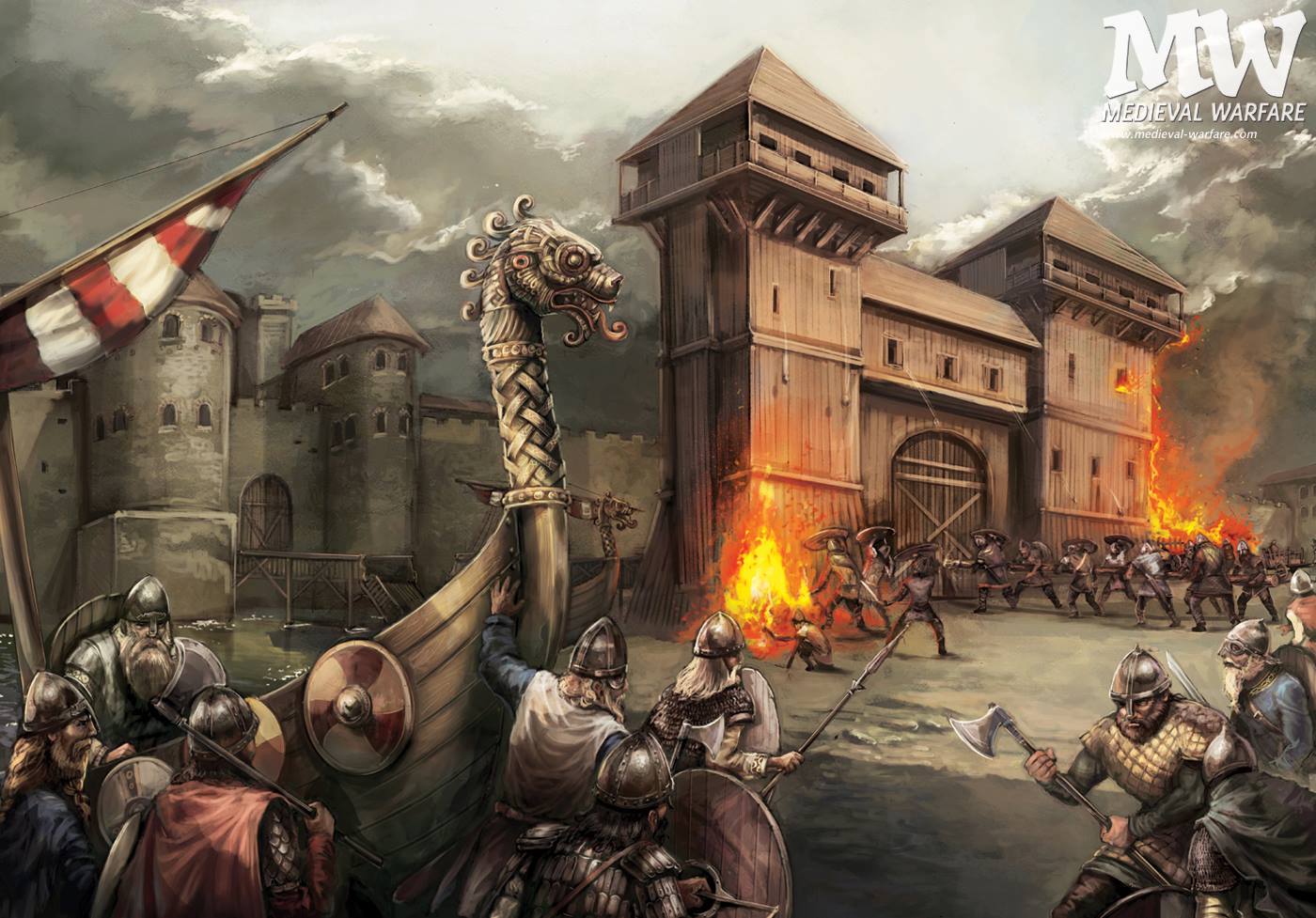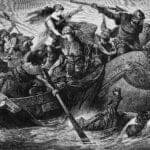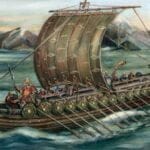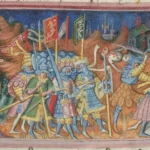Get ready for a thrilling ride through the mists of time as we unravel the epic tale of the Vikings and their daring raids on Paris. Dive into a meticulously crafted account, based on historical records, that will transport you to the heart of this legendary conflict. Explore the motives, tactics, and profound impact of these Norse warriors, and gain an eye-opening perspective on this pivotal chapter in European history. From the first siege to the enduring legacy, this comprehensive article will leave you captivated and enlightened about the Vikings’ enduring mark on the City of Lights.
Did Vikings Attack Paris Twice?
You bet they did! The Vikings, those fierce raiders from Scandinavia, weren’t afraid of a little adventure (or a lot of plunder). And they had their eyes set on Paris, not just once, but twice! Let’s dive into the hows and whys of these legendary attacks.
The First Surprise Attack: 845 AD
Imagine you’re a Parisian chilling out in the year 845. Life’s good, you’re enjoying the finer things, when suddenly, Viking longships come sailing up the Seine River! Talk about a rude awakening. This first attack was swift and brutal. The Vikings weren’t there to make friends – they tore through the city, causing chaos and destruction. They knew what they wanted: cold, hard silver and lots of it. And you know what? They got it. The terrified Parisians coughed up a hefty ransom to get the Vikings to leave. Crisis averted, for now…
Round Two: The Siege of 885 AD
You’d think after the first beatdown, the Vikings would be satisfied, right? Wrong. Just a few decades later, they came back for more. This time, they were led by a guy named Rollo, a legendary Viking leader who wasn’t about to take “no” for an answer. This wasn’t just a quick raid; it was a full-blown siege. For over a year, the Vikings laid siege to Paris, battling it out with the city’s defenders. It was a desperate struggle, but in the end, the Vikings’ tenacity (and perhaps their superior negotiating skills) won out. Once again, Paris paid a king’s ransom to get rid of them.
But Why Paris?
You might be thinking, “Why Paris?” Well, picture this: Paris sits on the Seine River, a perfect watery highway for Viking longships. It was a prime location, offering access to the heart of the Frankish kingdom. And Paris wasn’t just strategically important, it was wealthy! As a bustling trade center, it was overflowing with riches. Plus, the city’s monasteries and churches? Let’s just say they were holding some serious treasure that would make any Viking drool.
The Aftermath: Learning from the Past
These Viking attacks weren’t just historical footnotes. They sent shockwaves through the Frankish kingdom and forced them to rethink their defenses. The Franks realized they couldn’t just sit around waiting for the next Viking surprise party. They got to work building bridges and fortifications to better protect Paris.
A Story of Resilience
The Viking attacks on Paris are more than just tales of violence and destruction. They’re a testament to the city’s resilience and its ability to bounce back from adversity. They’re also a reminder of the power of adaptation – both for the Parisians who learned to defend themselves and for the Vikings who proved to be masters of strategy and opportunism.
Want to Learn More?
This is just a taste of a fascinating period in history. If you’re eager to delve deeper into the world of Vikings, their raids, and their lasting impact on Europe, check out these resources:
- [Books on Viking history]
- [Documentaries about the Viking Age]
- [Museums with Viking exhibits]
History is full of surprises, and the more we dig, the more fascinating stories we uncover. Who knows what other mysteries and adventures await in the annals of the past?
Did the Vikings Attack Paris a Second Time?
You bet they did! The Vikings weren’t known for giving up easily, and Paris, with its tempting riches and strategic location, was a prize they clearly had their eyes on. After their first shocking raid in 845, you might think they’d be satisfied. But the lure of Paris proved too strong to resist, and they decided to try their luck again in 885.
This second attack was a whole different beast. It wasn’t just a quick raid this time – the Vikings meant business. A powerful Viking chieftain named Rollo spearheaded this second siege. Imagine the fear that must have gripped the people of Paris as Rollo’s fleet appeared on the horizon. They knew what these fierce warriors were capable of.
Paris had learned a thing or two since the first attack and had strengthened its defenses, but it was still no match for Rollo’s determined Vikings. The city was effectively cut off, its usual bustling trade routes severed. Imagine being trapped inside the city walls, knowing that a relentless enemy was camped just outside. The siege dragged on for over a year, a terrifying period of constant threat.
Now, we don’t know all the gritty details of what went on during that year-long siege. The historical records are a bit sparse. But you can bet there were daring raids, desperate defenses, and probably more than a few stories of incredible bravery and cunning on both sides.
What we do know is that the Parisians, led by Count Odo, held their ground, refusing to give in to Rollo’s demands. Eventually, though, a combination of factors – dwindling supplies, perhaps, or the sheer exhaustion of constant warfare – forced them to make a deal. The siege was lifted, but not without Rollo getting his way. This event marked a turning point in Viking history, as it paved the way for their eventual settlement in the region we now know as Normandy.
So yes, the Vikings did attack Paris twice, and that second siege left an undeniable mark on the city’s – and indeed, France’s – story. It’s a reminder that the history books only tell us so much. The full story of those tumultuous years, with all its drama and human struggle, is likely lost to time.
How Many Times Was Paris Sieged?
Picking up where we left off, we know that Paris had its fair share of run-ins with the Vikings throughout the 9th century. These weren’t just quick raids, they were serious attempts to take over the city, and they played a huge role in making Paris what it is today.
So, how many times did the Vikings actually lay siege to Paris? Well, pinning down an exact number is tricky. Records from that time weren’t exactly like what we have today, and historians are still piecing together all the details. What we do know is that Paris was a tempting target for the Vikings, located on the Seine River and a hub for trade, making it ripe for the picking.
We already talked about the first big Viking raid in 845, led by the legendary Ragnar Lothbrok, which, while not as devastating as later attacks, definitely put Paris on the Viking map. It was like a warning shot, showing the city just how vulnerable it was. Would you like to know more about Ragnar Lothbrok, the legendary Viking hero?
Then came the big one – the siege of 885-886. This wasn’t just a quick in-and-out raid; this was a full-blown siege that lasted almost a year. The Vikings, led by Rollo, surrounded the city, cutting off their supplies and trying to break through the defenses. The people of Paris put up a fierce fight, but the Vikings were relentless.
Now, historians are always digging deeper, and there’s some debate about whether there might have been other smaller attacks or attempts to take the city during the 9th century. Some experts point to archaeological finds and old documents that suggest there’s more to the story than we currently know.
What’s clear is that these Viking sieges weren’t just historical footnotes. They had a huge impact on Paris. The city saw a lot of destruction, people lost their lives, and the economy took a major hit. But from these ashes, Paris also learned some valuable lessons. They realized they needed stronger defenses, and they started fortifying the city to withstand future attacks.
So, while we may not have a definitive number for how many times Paris was besieged, one thing is certain: these events left an enduring mark on the city, shaping its defenses, its spirit, and its place in history.
How Many Vikings Raided Paris?
We can’t say for sure exactly how many Vikings sailed up the Seine to lay siege to Paris. It’s not like they kept perfect attendance records! What we do know is that Paris was a juicy target for these seafaring raiders. Imagine being a Viking, hearing tales of this prosperous city brimming with gold and treasures, strategically located on a river that acted like a watery highway straight to its heart. They wouldn’t have passed up that opportunity!
While pinpointing the exact number of Viking raiders remains a mystery, historical records do point to several major assaults on Paris. The first recorded raid crashed upon the city in 845 AD. This initial attack made it abundantly clear that Paris, despite its defenses, was vulnerable to these fierce warriors from the north.
Perhaps the most famous siege unfolded in 885 AD and stretched on for almost a year. Can you imagine living under siege for that long? This prolonged assault underscored the Vikings’ evolving tactics. They weren’t just about smash-and-grab raids anymore. They were learning to adapt, strategize, and lay siege to well-defended cities.
Thankfully for the Parisians, they had a leader like Odo, the Count of Paris, who helped rally the city’s defenses and ultimately repelled the Vikings. However, these raids weren’t just fleeting events. They left scars on the city, impacting its economy, driving people from their homes, and forcing the city to bolster its defenses in preparation for future attacks.
The story of the Vikings in Paris is a complex one, woven from threads of history, archaeology, and a touch of mystery. While we may never know exactly how many Vikings participated in these raids, their impact on the city’s story is undeniable.
Did Ragnar Overtake Paris?
So, we know the Vikings had their sights set on Paris. But did Ragnar, the legendary Viking leader, actually conquer the city? Well, it’s a bit complicated.
In 845, Ragnar and his crew sailed right up the Seine River, outsmarting the Frankish defenses and basically taking Paris by surprise. King Charles the Bald, caught off guard, ended up paying a hefty ransom to get the Vikings to leave. Talk about an expensive visit! This event definitely showed how powerful the Vikings were and how vulnerable Paris was at the time.
But here’s the thing: while Ragnar’s raid was a major blow, it wasn’t a full-on conquest. He took their treasure and left, rather than sticking around to rule the city.
Fast forward a few decades to 885. The Vikings were back, and this time they were determined to stay. They laid siege to Paris for almost a whole year! Can you imagine living under siege for that long? This time, though, the people of Paris, led by Odo, fought back with everything they had. They held their ground and eventually forced the Vikings to retreat.
So, did Ragnar “overtake” Paris? He definitely raided it and caused a lot of chaos, but he didn’t manage to actually conquer and hold the city. The Parisians proved they were no pushovers, ultimately defending their home against some of the fiercest warriors in history. The story of the Vikings and Paris is full of twists and turns. Who knows what other historical mysteries are waiting to be uncovered?
Does Ragnar Conquer Paris in Season 4?
So, you’re caught up in the action of Vikings and wondering if Ragnar finally gets his hands on Paris in season 4? Well, it’s a bit of a tricky situation. The show takes some liberties with history. While we see Ragnar leading a pretty epic raid on Paris, the truth is, in real life, he was already gone by the time season 4’s events would have happened.
However, that doesn’t mean the Vikings just gave up on Paris. Back in 845 AD, Ragnar’s crew sailed right up the Seine and gave those Parisians a fright they wouldn’t forget, taking treasures and demanding a hefty payment from King Charles the Bald to leave peacefully.
Then, in 885 AD, the Vikings decided to pay Paris another visit. This time, it was Rollo, Ragnar’s brother (in the show, at least), leading the charge. They really meant business this time, surrounding the city for over a year! They put up a good fight, but in the end, King Odo of France managed to send them packing.
So, while Ragnar himself never conquered Paris like we see in the show, his legacy lived on through the Vikings who continued to test the city’s defenses. It makes you wonder, what else in the show might be a blend of fact and fiction, right?
Why Was Ragnar Peeing Blood?
So, we know Ragnar Lothbrok, the legendary Viking warrior, was a tough dude. But during the siege of Paris, even he couldn’t escape some brutal injuries. You see, when he fell from that siege tower, it wasn’t just a few bruises. We’re talking serious stuff here – historians believe he may have suffered a fractured spine. And yeah, that kind of injury can definitely lead to some scary stuff, including blood in the urine.
Think about it: a fractured spine means internal damage, and that damage can easily affect the urinary tract. So, it’s very possible that the blood in Ragnar’s urine was a direct result of that nasty fall. It’s a pretty graphic illustration of just how brutal Viking warfare really was.
However, there are other possibilities too. The siege of Paris wasn’t exactly a hygienic environment. Infections were probably rampant, and it’s entirely plausible that Ragnar could have picked up an infection in his urinary system, leading to blood in his urine – something doctors call hematuria.
Whatever the exact cause, one thing is clear: peeing blood is a terrible sign, and for Ragnar, it was a grim reminder of the toll his ambition was taking on his body. Yet, even with such horrific injuries, the guy was ready to keep fighting. That’s some next-level Viking toughness right there!
It really makes you think about the limits of human endurance and the sheer willpower that drove these warriors. We may never know for sure exactly what caused Ragnar’s condition, but his story continues to fascinate and remind us of the brutal realities of history.
What Episode Does Ragnar Conquer Paris the Second Time?
Okay, so here’s the thing. While the History Channel’s “Vikings” shows Ragnar Lothbrok leading two epic raids against Paris, the historical record suggests something a little different. You see, the actual second Viking siege of Paris went down in 885 AD, which was years after Ragnar’s presumed death around 865 AD. So, to answer your question directly, Ragnar doesn’t conquer Paris a second time in the show because it never actually happened – at least not according to what historians have pieced together.
The show takes some liberties with the timeline, probably to keep Ragnar, a fan favorite, in the thick of the action. It’s important to remember that “Vikings”, while entertaining, isn’t a documentary. It often blends fictional characters and plotlines with actual historical events.
Now, about that second siege… The Vikings who attacked Paris in 885 AD were under the command of a chieftain named Rollo. While the show portrays Rollo as Ragnar’s brother, there’s no historical evidence to support that claim. Some historians speculate that Rollo might have been loosely connected to Ragnar’s family through distant kinship ties or alliances, but it’s all a bit murky.
Despite the show’s fictionalized account, the historical siege of Paris in 885 AD was a major turning point in Viking history. It showed just how powerful and ambitious they had become, and it significantly impacted the political landscape of Europe at the time.
How Long Was Ragnar Gone After Paris?
So, we know Ragnar Lothbrok, the legendary Viking leader, went through a whole lot during the siege of Paris. I mean, the dude was seriously injured! We’re talking about injuries so bad that some historians believe they’re what eventually led to his death.
Now, if you’re a fan of the TV show “Vikings,” you might be thinking, “Wait a minute, didn’t Ragnar live for years after Paris?” And you’d be right, at least according to the show. But remember, the show takes some creative liberties with history.
The truth is, we don’t know exactly how long Ragnar lived after the siege. Historical sources from that time are kinda like a puzzle with missing pieces – we have some information, but not the whole picture.
What we can say for sure is that Ragnar’s injuries in Paris were no joke. Some historians suggest he might have suffered from something like kidney damage, which would have been a really big deal back then. Remember, they didn’t have fancy hospitals and antibiotics in the 9th century!
While the show portrays Ragnar leading more raids after Paris, many historians believe it’s more likely that his injuries caught up with him not long after the siege.
Think about it: leading a Viking raid across the sea required serious physical strength and stamina. It’s hard to imagine Ragnar, with injuries as severe as described, being able to bounce back and lead more epic adventures.
That being said, there’s always room for debate and new discoveries! Maybe some amazing archeological find will rewrite what we know about Ragnar.
Until then, the mystery of his fate after Paris continues to intrigue us.
Why Was Judith Tortured in Vikings?
So, remember how the Vikings raided Paris not once, but twice? Yeah, those guys weren’t exactly known for their gentle touch. But Judith’s situation was a whole different story. It wasn’t about ransoms or conquering cities this time. It was personal, steeped in the complex web of power, betrayal, and maybe even a dash of paranoia that ran rampant in the Viking world.
You see, after her husband, Aethelwulf of Wessex, died, Judith found herself in a very precarious position. Power struggles were pretty much the norm back then, and she, a woman in a male-dominated world, had to tread very carefully. Some historians believe that Judith’s torture at the hands of her stepson, Aethelbald, wasn’t a random act of cruelty, but a calculated move to consolidate his own power.
By publicly punishing Judith, Aethelbald could have been sending a clear message: he wasn’t to be trifled with. It’s also possible that Aethelbald was suspicious of Judith’s loyalty. After all, she was the mother of potential rivals to his throne. Torture, in its own twisted way, was a way to test her allegiance and ensure she wouldn’t undermine his rule.
Of course, we have to remember that we’re looking at this through the lens of history, and historical sources can be pretty vague sometimes. We don’t have Judith’s diary entries detailing her experiences, so we have to read between the lines and consider different perspectives. Some scholars even suggest that the “torture” might have been more symbolic in nature, a way to publicly humiliate Judith and strip her of her influence without resorting to physical violence.
It’s a murky and uncomfortable part of history, but it reminds us that power dynamics were incredibly complex, especially for women who dared to navigate the treacherous waters of politics and leadership. Judith’s story, though shrouded in ambiguity, continues to fascinate and provoke discussion amongst historians and “Vikings” enthusiasts alike.
Is the Show Vikings Historically Accurate?
You ask, did the Vikings attack Paris twice? You bet they did! And let me tell you, the story of the Vikings and Paris is like something straight out of a movie – full of daring raids, fierce battles, and enough gold and glory to make your head spin. We’re not just talking about a quick in-and-out raid either. These Norse warriors sailed right up the Seine River, planting themselves right in the heart of France.
The First Viking Visit: A Not-So-Friendly Drop-In (845 AD)
Picture this: It’s 845 AD, and a massive fleet of Viking longships appears on the horizon. Leading the charge is none other than the legendary Ragnar Lodbrok, a name that still sends shivers down spines. They weren’t there to sightsee, that’s for sure. Their goal? To grab as much treasure as they could and leave their mark on the city. The Parisians, caught off guard, put up a fight but ultimately had to cough up a king’s ransom to get Ragnar and his crew to leave. It was a humiliating blow that left the Franks reeling.
Round Two: The Vikings Aren’t Done Yet (885-886 AD)
You’d think one ransacking would be enough, right? Not for the Vikings. Just a few decades later, they were back for more. This time, a Viking leader named Rollo was calling the shots. Rollo was determined to outdo Ragnar’s raid and make Paris his own personal piggy bank. This time, though, the Parisians were ready. Led by the courageous Count Odo, they dug in their heels and fought back with everything they had. The siege dragged on for over a year, a brutal back-and-forth that would go down in history. In the end, the Vikings, worn down but still proud, took another hefty payment and sailed away.
More Than Meets the Eye: The Viking Game Plan
Now, you might think these Vikings were just greedy barbarians with a thing for shiny loot. And while they certainly didn’t mind a bit of gold and silver, there was a method to their madness. These were smart cookies – skilled negotiators who understood that there was more to gain than just quick riches. By shaking things up in Frankia (that’s what France was called back then), they gained leverage. They used their raids to forge alliances, open up trade routes, and position themselves as a major power. It was like a giant game of Risk, Viking-style.
Vikings on the Small Screen: Fact or Fiction?
Fast forward to today, and the History Channel’s “Vikings” has everyone talking about Ragnar, Lagertha, and the rest of the gang. The show is a wild ride, full of epic battles and juicy drama, but how much of it lines up with the history books? Well, that’s where things get interesting. The show definitely captures the spirit of the Viking Age – the sense of adventure, the clash of cultures, the sheer audacity of it all. But it also plays fast and loose with the timeline, merges real-life figures, and throws in fictional characters to spice things up. Think of it as historical fiction inspired by real events.
The Takeaway
So, there you have it. The Vikings did indeed raid Paris twice, leaving their mark on the city and its people. They were driven by a mix of greed, ambition, and a desire to make their mark on the world. And while the “Vikings” TV show might not be a completely accurate history lesson, it does offer a glimpse into the lives and times of these fascinating and complex people.
Want to Learn More?
There’s a ton of fascinating stuff out there about the Vikings and their raids on Paris. Here’s a good place to start: Siege of Paris (845))
- Mastering Leader in Spanish: The Complete Guide - April 19, 2025
- Uncovering Surprising Parallels: England Size Compared to US States - April 19, 2025
- Old Mexico Map: Border Shifts 1821-1857 - April 19, 2025
















